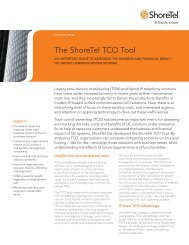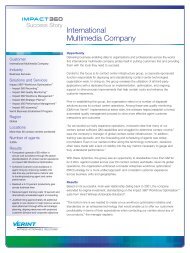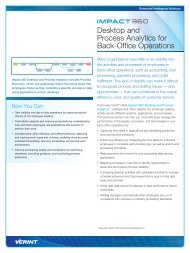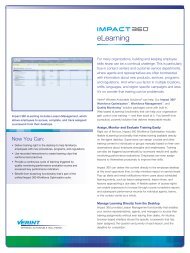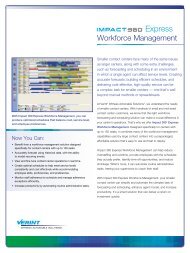ShoreTel: How UC Pays for Itself - Windstream Communications
ShoreTel: How UC Pays for Itself - Windstream Communications
ShoreTel: How UC Pays for Itself - Windstream Communications
Create successful ePaper yourself
Turn your PDF publications into a flip-book with our unique Google optimized e-Paper software.
7. Improve communications to optimize processesThe previous examples focus on improved efficiencies. There are also demonstrablerevenue opportunities when <strong>UC</strong> tools are incorporated into business processes andworkflows. Many of these are based on improved collaboration among a workgroup,department, or project team. The use of <strong>UC</strong> tools to speed collaboration or findresources among these groups can have dramatic impacts on how work gets done.Shorter sales cycles both speed revenues and improve sales closure rates. New productscan be brought to market in less time and with lower development costs. Faster decisionmakingand rapid problem resolution remove delays from normal business operations.All of these accelerate business processes, which can frequently mean greater and fasterrevenue recognition.<strong>UC</strong> capabilities, properly deployed, can bring improvements outside the company wallsas well. One of the biggest opportunities is to build better communication links betweena company and its partners, suppliers, and customers. Through federation of presencein<strong>for</strong>mation and links to other IM engines, staffers can interact more effectively withthose outside the enterprise. In other cases, communications-enabled portals can allowpeople outside the company who have close business relationships with those inside toestablish secure communication links. This allows more rapid communications of deliverystatus, orders, technical in<strong>for</strong>mation, as well as direct communications between theparties. Enabling these sorts of capabilities simply means that it’s easier to do businesswith the company.For customers, of course, this turns into greater satisfaction, greater loyalty, andincreased business opportunities. For suppliers it means more efficient operationsand faster ways to resolve any issues that arise. For partners, communications-enabledsolutions make the company “easier to do business with.” In today’s economy, thesesorts of benefits are compelling.<strong>How</strong> Unified <strong>Communications</strong> <strong>Pays</strong> For <strong>Itself</strong>! PAGE 8
8. <strong>UC</strong> success storiesMany suppliers have reported dramatic examples and case studies of how unifiedcommunications capabilities have made dramatic improvements in their customers’operations. Here is a specific example from <strong>ShoreTel</strong>:TopLine Federal Credit Union has been serving the Minneapolis/St. Paul, Minnesotametropolitan area <strong>for</strong> decades. Today it has more than 30,000 members and providespremium personal service “that people can bank on.” With numerous full-servicebranch locations throughout the Twin Cities, TopLine offers quality financial products,competitive rates, low fees, online banking and shared branching services.By leveraging <strong>ShoreTel</strong>’s integrated unified communications capabilities, TopLine hasbeen able to reduce the amount of time <strong>for</strong> addressing customer issues. For example,instant messaging is used across multiple sites. By knowing the presence status ofsubject matter experts in any location at any time, service representatives are able toget the latest in<strong>for</strong>mation in less time and with less ef<strong>for</strong>t. For more complex issues,they are able to escalate an instant message into a phone call with the touch of abutton, resulting in rapid resolution of customer issues and enabling superior customersatisfaction.These innovations have allowed the credit union employees to focus on retainingcustomers, spending more time with their valued clients, improving service, andcreating the most positive experience possible <strong>for</strong> all of their customers. TopLinemanagement reports savings of support and maintenance costs of over 40 percent, asignificant decrease in call wait times, an increase in call completions, as well as out-ofpocketsavings by eliminating POTS lines.<strong>How</strong> Unified <strong>Communications</strong> <strong>Pays</strong> For <strong>Itself</strong>! PAGE 9
9. Implementation planning<strong>UC</strong> supports different types of use cases, and a variety of different avenues to costjustification. Similarly, there are also a variety of ways that <strong>UC</strong> solutions can be deployed.• .In some cases, companies purchase <strong>UC</strong> functionality and roll it out broadly to all staff.Typically this approach focuses on <strong>UC</strong>-U opportunities.• .In others, the company will look <strong>for</strong> specific opportunities <strong>for</strong> <strong>UC</strong> functionality toimprove selected business processes or workflows (<strong>UC</strong>-B). This method can requireadditional upfront planning but typically provides substantially greater benefits.• Finally, there are techniques to deploy <strong>UC</strong>-U first and then incorporate <strong>UC</strong>-Bopportunities in the future.The goal of a <strong>UC</strong>-U deployment is to enable all staff to gain personal productivitybenefits. Quite frequently we find that this approach accompanies the replacement ofa legacy PBX environment with a new IP PBX solution. In many cases, the fundamentaldriver was to replace the PBX, and <strong>UC</strong> enhancements are viewed as an added benefit.<strong>UC</strong>-U deployments are often led by the IT or telecom departments with relatively littleinvolvement from business managers.In a <strong>UC</strong>-B deployment, the approach is different. Here, the goal is to identify specificbusiness processes in which communications bottlenecks or barriers exist. This meansthat the IT staff often have to work with someone from business management oroperations who can help identify appropriate opportunities. IT understands the systemcapabilities; the business manager understands where the best opportunities exist.One effective technique is to review company workflows and processes and look <strong>for</strong>areas where inadequate communications cause errors, delays, or rework. This is, ofcourse, similar to the use of lean six sigma techniques:• Start with an overview of the company’s processes• .Zero in on those that have high value or high volume and where communicationchallenges impede the process• Determine which of these “hot spots” can be mitigated by applying <strong>UC</strong> capabilities• Translate these opportunities into use cases <strong>for</strong> how processes will work and thebenefits available• Organize and prioritize opportunities to create a roadmap of <strong>UC</strong> projects• Design an action plan <strong>for</strong> implementation<strong>How</strong> Unified <strong>Communications</strong> <strong>Pays</strong> For <strong>Itself</strong>! PAGE 10






